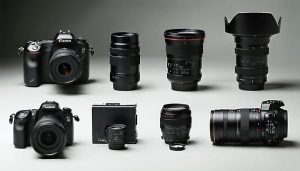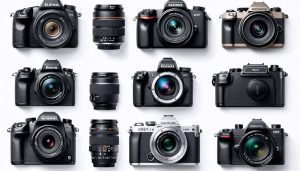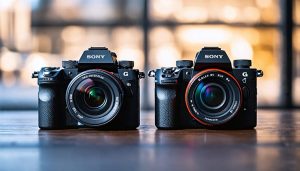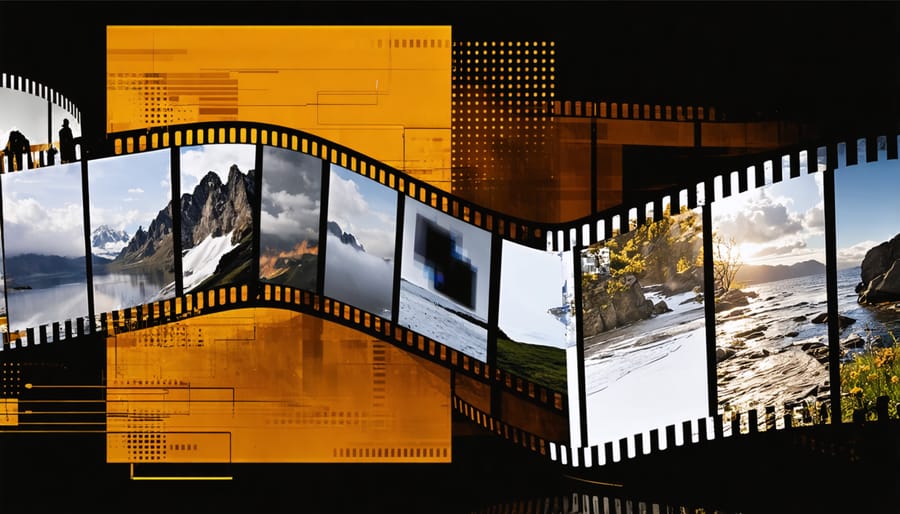
Advanced Photo System (APS) film revolutionized consumer photography in the mid-1990s, bridging the crucial gap between traditional film vs digital photography. This innovative format introduced groundbreaking features that would later influence digital camera design, including multiple aspect ratios, automated film loading, and magnetic data storage for exposure information. While its commercial lifespan lasted just over a decade, APS represented a significant milestone in photography’s evolution, introducing conveniences we now take for granted in modern digital cameras. Despite its discontinuation in 2011, APS remains a fascinating chapter in photographic history, demonstrating how technological innovation can reshape creative tools even in the twilight years of analog photography. For collectors and photography enthusiasts, APS cameras and films offer a unique glimpse into the industry’s last major attempt to modernize film photography before the digital revolution took hold.
The Revolutionary Features of APS Film
Multiple Print Formats
One of APS film’s most innovative features was its ability to capture photos in three distinct formats using the same roll of film. The Classic (C) format produced traditional 4×6-inch prints with an aspect ratio of 3:2, similar to 35mm film. High Definition (H) format created 4×7-inch prints with a wider 16:9 aspect ratio, perfect for landscapes and group shots. The Panoramic (P) format delivered striking 4×11-inch panoramic prints with an expansive 3:1 aspect ratio, ideal for sweeping vistas and architectural photography.
Photographers could choose their preferred format for each shot by using a selector switch on their APS camera. The film recorded these format choices magnetically, ensuring the photo lab would print each image exactly as intended. The versatility of switching between formats on the same roll gave photographers creative freedom without carrying multiple cameras or changing film types.
Despite the slightly smaller negative size compared to 35mm film, these multiple print formats made APS an attractive option for both casual photographers and enthusiasts looking to experiment with different compositional styles.

Magnetic Information Strip
One of APS film’s most innovative features was its magnetic information strip, which ran along the entire length of the film. This transparent magnetic coating, known as XI (Information Exchange), allowed cameras to record and store vital shooting data directly onto the film itself. The strip could capture up to 31 different types of information, including date, time, exposure settings, lighting conditions, and even the photographer’s intended print format.
When processing the film, photo labs could read this magnetic data to optimize print quality and automatically determine the correct aspect ratio for each frame. The system could even store voice memos recorded by the photographer, though this feature was only available in select high-end cameras.
This magnetic storage capability represented a significant advancement over traditional film, bridging the gap between analog and digital photography. While common in professional cameras today, this ability to store metadata alongside images was revolutionary for its time, making APS a pioneering format in photography’s evolution toward the digital age.
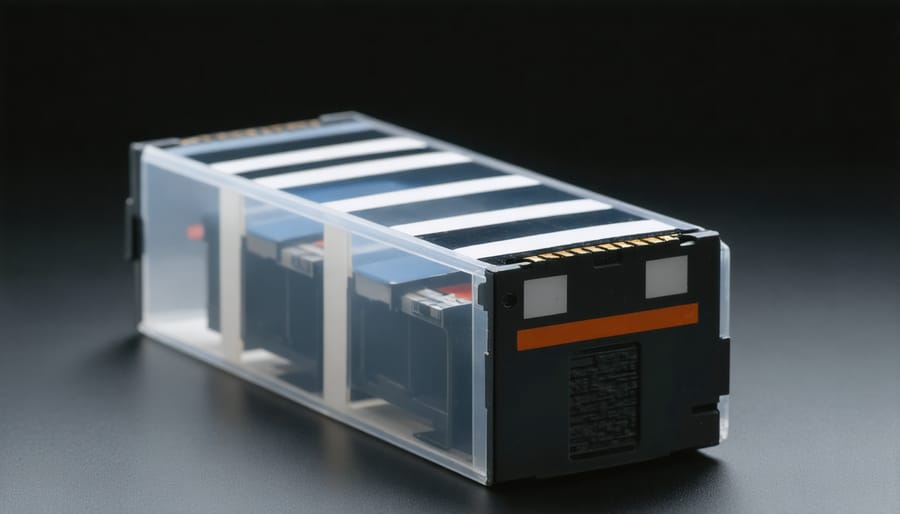
Drop-in Loading System
One of APS film’s most innovative features was its foolproof Drop-in Loading System (IX). Unlike traditional 35mm film that required careful threading, APS cartridges simply dropped into the camera chamber. The film’s spool was fully enclosed in a protective shell, eliminating the risk of light exposure or finger contact with the film surface. Users couldn’t accidentally load the film backwards or incorrectly, thanks to keyed slots that ensured proper orientation. The system also prevented mid-roll removal, protecting your images from accidental exposure. When the roll was finished, the film rewound completely into its cartridge, making it safe to remove at any time. This user-friendly approach made APS cameras particularly appealing to casual photographers and helped reduce common film-loading mistakes that plagued earlier formats.
Technical Specifications and Performance
Film Size and Resolution
APS film offered a unique balance of portability and image quality, though it never quite matched the resolution of traditional 35mm film. The standard APS negative measured 30.2 × 16.7mm, roughly 56% of the surface area of a 35mm frame (36 × 24mm). This smaller size meant that photographers had to be more mindful of their shooting conditions to achieve optimal results.
Despite its smaller dimensions, APS film typically delivered sharp, detailed images thanks to advances in film emulsion technology. The format offered three distinct aspect ratios: H (16:9), C (3:2), and P (3:1), all captured on the same negative size. This versatility was unprecedented at the time, though it came at the cost of some image real estate compared to 35mm.
In terms of resolution, a typical APS frame could resolve approximately 18-20 megapixels worth of detail under ideal conditions, compared to 35mm film’s theoretical resolution of 24-30 megapixels. However, the actual perceived quality difference was often less noticeable in regular print sizes up to 8×10 inches.
The format’s magnetic coating allowed for superior print consistency and automated processing, which partially compensated for any resolution limitations. Professional photographers primarily stuck with 35mm for its superior resolution and larger negative size, while enthusiasts appreciated APS for its convenience and consistent results in everyday shooting scenarios.
Compatible Cameras
Several major camera manufacturers embraced the APS format during its brief commercial run. Nikon introduced the Pronea series, including the advanced Pronea 6i, which offered professional-grade features. Canon’s popular ELPH/IXUS line became synonymous with compact APS cameras, with models like the IXUS II combining sleek design with user-friendly operation. Before making any purchase decisions, it’s worth consulting our comprehensive camera buying guide for detailed insights.
Minolta’s Vectis series stood out for its innovative features, particularly the Vectis S-1, which offered interchangeable lenses. Fujifilm contributed with their Endeavor series, while Samsung and Kodak also produced notable APS cameras. High-end models like the Contax Tix and Leica Minilux Zoom featured premium optics and build quality, targeting enthusiast photographers.
While new APS cameras are no longer manufactured, many models remain available on the secondary market. The most reliable options tend to be the later-generation cameras from major manufacturers, particularly those from Canon, Nikon, and Minolta, which typically offer better build quality and more sophisticated features.
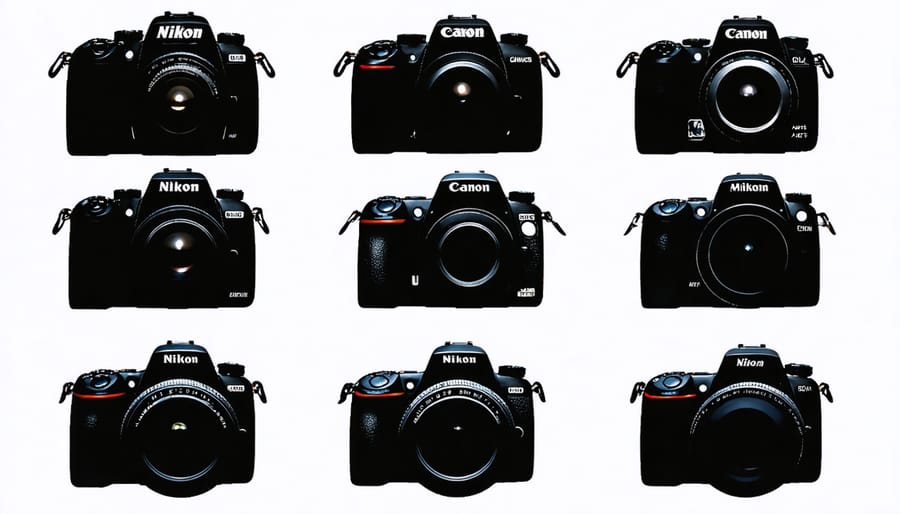
Impact on Modern Photography
Digital Photography Features Inspired by APS
Many features we take for granted in modern digital cameras can trace their roots back to innovations first introduced with the Advanced Photo System. This fascinating evolution of camera technology shows how APS served as a crucial bridge between traditional film and digital photography.
The magnetic strips on APS film that stored exposure data and print format choices evolved into the EXIF data we now find embedded in every digital photo. Similarly, the ability to choose between three different aspect ratios (H, P, and C formats) while shooting laid the groundwork for the multiple crop modes available in today’s digital cameras.
APS’s drop-in film loading system inspired the user-friendly interface designs we see in modern cameras, where complexity is hidden behind intuitive controls. The format’s mid-roll change capability influenced the way digital cameras handle multiple memory cards and quick-switching between different shooting modes.
Perhaps most significantly, APS’s integration of data recording with image capture set the stage for modern metadata systems, enabling photographers to store detailed information about each shot. Features like date stamping, exposure settings, and scene type identification – all revolutionary for their time in APS – are now standard in digital photography, though in vastly more sophisticated forms.
The APS Legacy in Camera Design
While APS film itself may be obsolete, its influence on camera design continues to shape modern camera innovations today. The system introduced several user-friendly features that we now take for granted in digital cameras. The most notable contribution was the intuitive interface design, including the LCD panel that displayed essential shooting information and camera settings – a feature that became standard in digital cameras.
APS cameras pioneered the concept of multiple aspect ratios, allowing photographers to switch between classic, wide, and panoramic formats with the push of a button. This flexibility influenced how modern cameras handle different shooting formats and aspect ratios. The system also introduced magnetic strips for storing shooting data, a precursor to today’s detailed EXIF information in digital images.
The ergonomic design of APS cameras, with their simplified controls and automated features, set a new standard for user-friendly photography. Many of these design principles carried over into early digital cameras and continue to influence contemporary camera layouts. The drop-in film loading system, while specific to film, demonstrated how mechanical operations could be simplified for users – a philosophy that persists in today’s camera designs through features like automated sensor cleaning and intuitive menu systems.
Collecting and Using APS Equipment Today
Finding and Maintaining APS Cameras
Despite APS being discontinued in 2011, finding and maintaining APS cameras is still possible for enthusiasts interested in buying vintage camera equipment. Popular marketplaces like eBay, local camera shops, and photography forums often have APS cameras available at reasonable prices.
When purchasing an APS camera, pay special attention to the film chamber and magnetic head reader. These components are crucial for proper operation and can be challenging to repair if damaged. Look for cameras that have been stored in climate-controlled environments, as extreme temperatures and humidity can affect their reliability.
To maintain your APS camera, store it in a dry place with silica gel packets to prevent moisture damage. Regular cleaning of the film chamber and magnetic heads using isopropyl alcohol and cotton swabs will help ensure smooth operation. Keep the lens cap on when not in use and remove batteries during long storage periods to prevent corrosion.
Film itself requires careful handling. Store unused APS film in a refrigerator around 55°F (13°C) to preserve its quality. Before shooting, allow the film to reach room temperature for at least two hours to prevent condensation issues. While finding new APS film can be challenging, some specialty retailers still carry expired stock that can produce interesting results when properly stored.
Remember that service options for APS equipment are limited, so preventive maintenance is essential for longevity.
Film Availability and Processing
As of 2024, APS film has become increasingly scarce in the commercial market. Kodak discontinued production of APS film in 2011, followed by Fujifilm in 2017, marking the end of new film manufacturing. While some expired APS film can still be found through specialty retailers and online marketplaces, photographers should be aware that image quality may be compromised due to age-related deterioration.
Processing APS film has also become challenging. Many local photo labs have retired their APS processing equipment, though some specialized labs continue to offer this service. Notable labs like Dwayne’s Photo in Kansas and The Darkroom in California still process APS film, albeit at premium prices compared to 35mm processing. These labs typically charge between $15-30 per roll, not including scanning or printing services.
For photographers with existing APS film collections, proper storage is crucial. Keep films in cool, dry conditions (around 55°F/13°C with 30-40% humidity) to preserve their viability. When sending films for processing, consider using tracked shipping methods and discussing options with the lab beforehand, as some may need advance notice to prepare their equipment.
While the format is essentially obsolete for new photography, understanding APS film remains relevant for archival purposes and handling historical images shot on this format.
While Advanced Photo System film’s commercial lifespan was relatively brief, its impact on photography continues to resonate today. APS introduced several innovations that would later become standard features in digital cameras, including aspect ratio selection, automatic film loading, and enhanced data recording capabilities. The format’s emphasis on user-friendly features and simplified operation helped bridge the gap between traditional film photography and the digital revolution that followed.
Though APS cameras and film are no longer in production, their influence can be seen in modern camera design, particularly in the implementation of metadata storage and shooting mode indicators. The format’s IX coding system laid important groundwork for the development of digital image organization and cataloging systems we use today.
For collectors and photography enthusiasts, APS represents a fascinating chapter in photographic history – a last ambitious attempt to innovate within the realm of consumer film photography before digital technology became dominant. While the format itself may be obsolete, its legacy lives on in the countless technological improvements it pioneered, many of which we now take for granted in our digital imaging world.

